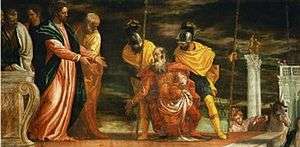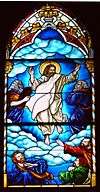Healing the centurion's servant
Healing the centurion's servant is one of the miracles said to have been performed by Jesus of Nazareth as related in the Gospels of Matthew[1] and Gospel of Luke (both part of the Christian biblical canon). The story is not recounted in the Gospels of either John or Mark.[2]

According to these accounts, a Roman centurion asks Jesus for his help because his servant is ill. Jesus offers to go to the centurion's house to perform a healing, but the centurion hesitates and suggests that Jesus' word of authority would be sufficient. Impressed, Jesus comments approvingly at the strong religious faith displayed by the soldier (despite not being a Jew) and grants the request, which results in the servant being healed the same day.
Sources
Scriptural sources
The story of the Centurion appears both in the Gospel of Matthew and that of Luke:
When Jesus had entered Capernaum, a centurion came to him, asking for help. "Lord," he said, "my servant lies at home paralyzed, suffering terribly." Jesus said to him, "Shall I come and heal him?" The centurion replied, "Lord, I do not deserve to have you come under my roof. But just say the word. For I myself am a man under authority, with soldiers under me. I tell this one, 'Go,' and he goes; and that one, 'Come,' and he comes. I say to my servant, 'Do this,' and he does it." When Jesus heard this, he was amazed and said to those following him, "Truly I tell you, I have not found anyone in Israel with such great faith. I say to you that many will come from the east and the west, and will take their places at the feast with Abraham, Isaac and Jacob in the kingdom of heaven. But the subjects of the kingdom will be thrown outside, into the darkness, where there will be weeping and gnashing of teeth." Then Jesus said to the centurion, "Go! Let it be done just as you believed it would." And his servant was healed at that very hour.
Luke 7:1–10 (TNIV)
When Jesus had finished saying all this to the people who were listening, he entered Capernaum. There a centurion's servant, whom his master valued highly, was sick and about to die. The centurion heard of Jesus and sent some elders of the Jews to him, asking him to come and heal his servant. When they came to Jesus, they pleaded earnestly with him, "This man deserves to have you do this, because he loves our nation and has built our synagogue." So Jesus went with them. He was not far from the house when the centurion sent friends to say to him: "Lord, don't trouble yourself, for I do not deserve to have you come under my roof. That is why I did not even consider myself worthy to come to you. But say the word, and my servant will be healed. For I myself am a man under authority, with soldiers under me. I tell this one, 'Go,' and he goes; and that one, 'Come,' and he comes. I say to my servant, 'Do this,' and he does it." When Jesus heard this, he was amazed at him, and turning to the crowd following him, he said, "I tell you, I have not found such great faith even in Israel." Then the men who had been sent returned to the house and found the servant well.
Origins
The story of the Centurion is not mentioned in the Gospel of Mark, the earliest of the four gospels. One theory is that material not in Mark but found in both Matthew and Luke may have came from a lost source known as "Q". If true then this passage would still be an anomaly as Q is believed to have been a collection of sayings of Jesus (a list of sermons and quotations) with no other contextual material; but the story of the Centurion does include background detail. It would also be the only miracle story that originated in Q. One possibility is that only the dialogue was in Q, and both Matthew and Luke added the background details from a shared oral history.[3]
The Gospel of John does narrate the account of Jesus healing the son of a royal official at Capernaum at a distance in John 4:46–54. Some modern commentators[4] treat them as the same event. However, in his analysis of Matthew, R. T. France presents linguistic arguments against the equivalence of pais and son and considers these two separate miracles.[5] Merrill C. Tenney in his commentary on John[6] and Orville Daniel in his Gospel harmony[7] also consider them two different incidents.
Use in the liturgy
The words of the Centurion are used in the Prayer of Humble Access contained in many Anglican, Methodist, Presbyterian, and other Christian Eucharist liturgies.[8] The words are also used as part of the Communion rite in the Roman Rite of the Catholic Church.
Interpretations
According to I. Howard Marshall, there were no Roman forces in Galilee prior to AD 44; therefore, the soldier was probably a member of Herod Agrippa's troops, which modeled Roman organization. While his nationality is not given, he is clearly a Gentile.[9]
Meaning of "servant"
Luke 7:2 and 7:10 refer to the person to be healed as doulos, unambiguously meaning "servant" but has the Centurion himself call him "pais" – which has a number of more ambiguous meanings including "child" (e.g., Matt 2:16, "son" (John 4:51) and, "servant" (Luke 15:26, Acts 4:25).
References
- "Matthew 8:5–13". Biblegateway.com. Retrieved 2018-04-19.
- "Luke 7:1–10". Biblegateway.com. Retrieved 2018-04-19.
- Keener, Craig S. (1999). A Commentary on the Gospel of Matthew. Wm. B. Eerdmans. p. 264. ISBN 978-0-8028-3821-6.
- Fred Craddock: Luke, 2009 ISBN 0-664-23435-6, page 94
- The Gospel according to Matthew: an introduction and commentary by R. T. France 1987 ISBN 0-8028-0063-7 page 154
- Merrill Tenney: John, Expositor's Bible Commentary, vol. 9, Zondervan.
- Orville Daniel: A Harmony of the Four Gospels, 2nd Ed, Baker Books Pub.
- Marion Hatchett, Commentary on the American Prayerbook, New York: Seabury Press, 1981. p. 382
- Marshall, I. Howard, The Gospel of Luke, Wm. B. Eerdmans Publishing, 1978, p. 279 ISBN 9780802835123
